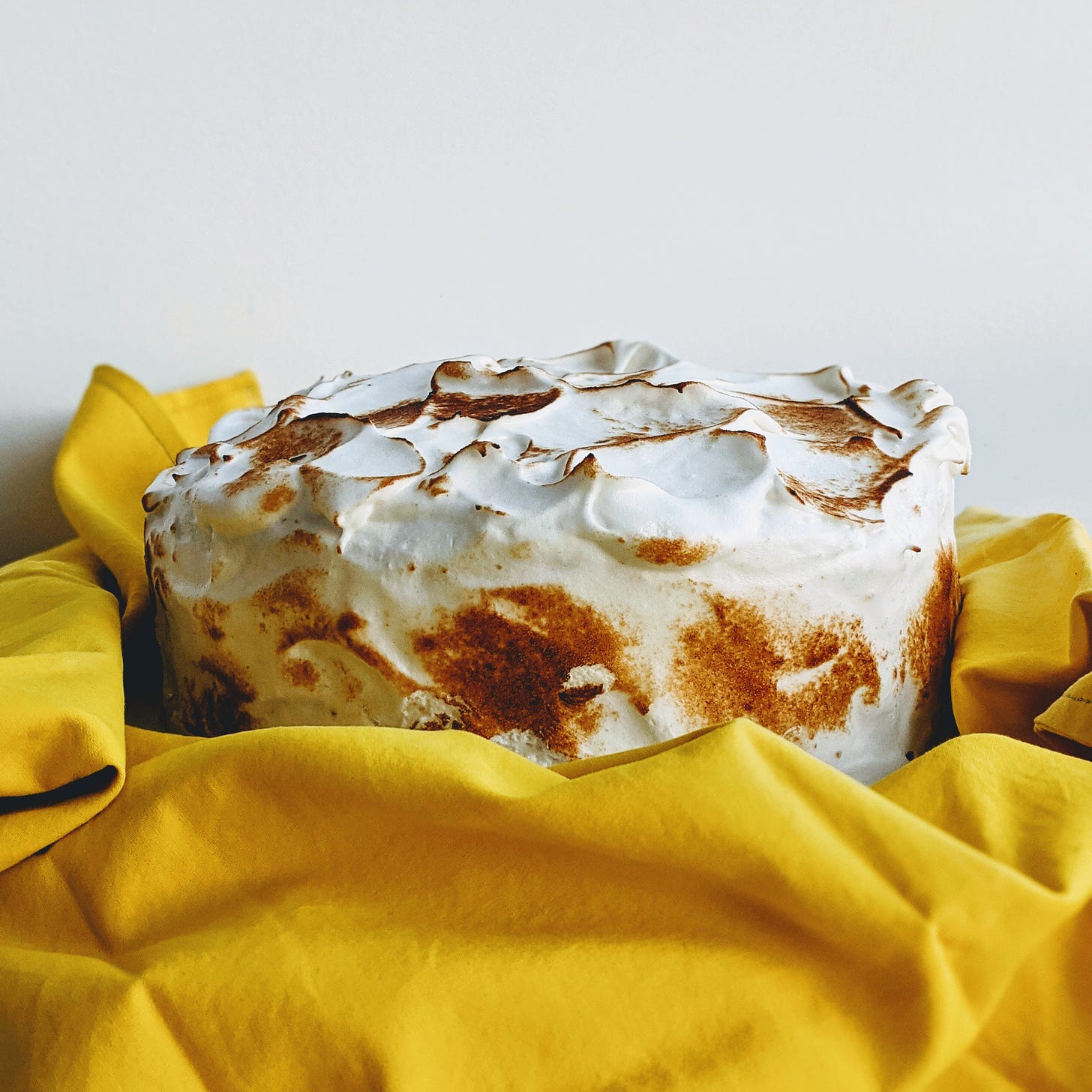Let me introduce you to the cult of Claire Saffitz. Once a lowly associate test kitchen editor at Bon Appetit magazine, Saffitz rose to YouTube superstardom with her hit series Gourmet Makes. The schaudenfreude delights of watching her struggle to recreate junk food snacks from scratch in the Bon Appetit test kitchen would bring millions of viewers to the magazine’s channel, turning the staff there into the beloved Bon Appetit Cinematic Universe. (That is, until their happy-office-family image was shattered by the revelation of racially discriminatory pay disparity last summer.)
One of my friends once compared Saffitz to a figure from Greek mythology who was sentenced the eternal punishment of being forced to figure out how to reverse engineer Doritos and Pop Rocks for the rest of her days. She certainly achieved godlike status among food influencers, with her own hashtag, #iwdfcsftbatk -- “I would die for Claire Saffitz from the Bon Appetit Test Kitchen.” Now, since joining numerous white video hosts in leaving the channel in support of their POC colleagues who were unable to negotiate higher pay in the aftermath of the summer’s reckoning, she has broken from her extremely-well-compensated servitude with a best-selling cookbook.
In the introduction to Dessert Person: Recipes and Guidance for Baking with Confidence, Saffitz sums up the project: “to celebrate and defend [her] love of desserts, and also to empower reluctant home bakers to work with new ingredients, attempt new techniques, and bake with more confidence.” From my perspective as an experienced home baker, she delivers. Every one of the 10+ recipes I’ve made out of this book has been a slam dunk.
I’ll admit, on my first read-through, I was skeptical as to if this book was actually approachable for beginners. All of the recipes are rated on a five-point scale from “very easy” to “very challenging,” and they are organized by difficulty within each chapter. Great start! But I’m not sure I would rate making a mousse and sugared cranberries (Cranberry-Pomegranate Mousse Pie) or making a mango caramel sauce (Rice Pudding Cake with Mango Caramel) as “easy” for someone just starting out.
However, Saffitz’s recipes are so detailed, it’s hard to go wrong. She emphasizes paying attention to doneness indicators rather than timing in her recipes, so that it’s clear when to take a cake out of the oven, when to turn off the heat on a caramel, or when to stop kneading a dough based on in-depth sensory descriptions and some instructional photos. All of her ingredient lists include weight measurements as well as volume, and she’ll even give you the weight of batter that should go in a layer cake tin or a single ball of cookie dough for ultimate precision. Her recipes for molasses cookies, flourless chocolate cake, and pie crust turned out best-in-class renditions of their category.
After seeing the success of these recipes I was familiar with, I felt empowered to give baked goods that had always intimidated me a shot. I spent three days making the Preserved Lemon Meringue Cake (one to bake the layers, one to make the lemon curd, and one to make the meringue frosting and assemble the cake), and was rewarded with a tender lemon cake with a uniquely punchy/salty undertone that stunned the friend I gifted it to for her birthday. I’ve historically struggled with egg whites, and the meringue preparation required precise timing and attention to temperatures and textures, but the clear instructions and photos enabled me to nail it on the first try. And I even got to borrow and try out a kitchen blowtorch!
I also have always been intimidated by working with yeast in baking. My partner nursed an obsession with bread baking for years that has led me to see yeast baking as requiring a lot of practice to earn an intuitive relationship to the dough. I’ve generally stuck to no-knead recipes when I wanted to make pizza or flatbread, and that’s about it. But the reliability of Saffitz’s recipes throughout this book encouraged me to try my hand at her brioche dough recipe and make the Brioche Twists. The dough that came together in my stand mixer was incredibly soft and supple, and I gave it an optional overnight nap in the fridge to bolster development of gluten structure and flavor. I made the crunchy sugar coating with cardamom and orange zest rather than ground coriander, and used a video about how to shape Swedish cardamom pastries to help me form the buns. The final product was bakery quality: beautifully golden brown, fluffy, and lightly sweet. I’m excited that the Brioche Twists recipe only uses half the quantity of her brioche dough recipe, so I have more dough in the freezer that I can bake up any time.
I will say, one of my quibbles with the book is the claim in the introduction, “most ingredients are ones you can find at any well-stocked grocery store.” I guess that’s technically true, but most recipes include at least one unusual ingredient that’s pretty difficult to find outside a Whole Foods or a diverse city. Saffitz is upfront that “some of the recipes feature clever, unexpected elements or flavor combinations.” The tea cake is basically a pumpkin cake but with kabocha squash, turmeric, and garam masala. The lemon cake uses preserved lemons. The buttermilk biscuits get a cheesy flavor from miso.
For readers familiar with Bon Appetit recipes, this kind of restless swapping in of ingredients from around the world to achieve certain flavor objectives isn’t surprising, but it does brush uncomfortably close to issues around cultural appropriation/erasure by white chefs which have swirled around Bon Appetit and Alison Roman in particular. To her credit, Saffitz is pretty good about providing context for these kinds of ingredients in her topnotes (which was a perennial problem with Alison Roman) and is reasonably working to expand readers’ horizons. I think an addition that would have solved a couple of problems here would be to just admit that a lot of readers would have to order these ingredients online, and provide a section with recommendations for websites or brands to order from, which might also lead people deeper into the cuisines from which these ingredients originate.
Overall, I really love this book, and am constantly turning to it to make gifts for friends (ironically, I am not really a dessert person). I do think Saffitz underestimates some of the challenges her recipes might present to beginners, but the extremely detailed instructions will guide you to success if you stick with it. Dessert Person has given me the confidence to try new things even with ten years of baking for friends under my belt, and I hope it will do the same for you.
Further reading:
Everything I have to say about the questionable, context-collapsing, white chef practice of pulling ingredients from other cultures is summed up in this excellent piece, “Stewed Awakening: Alison Roman, Bon Appetit, and the Global Pantry.” I wanted to write an issue about this but this essay really covers it all, so I truly hope you read it!
The Reply All podcast just launched a new series on the systematic racism at Bon Appetit. It’s an extremely nuanced and emotional exploration that centers the voices of former employees of color (including the woman who styled Dessert Person, who used to be a temp recipe tester there). I do want to flag that it’s a pretty painful listen for people who have experience with racism in the workplace so some might want to proceed with caution.
Next issue: We’ll look at cookbooks that defy the the context-collapse of the global pantry. Written by two food bloggers, Molly Yeh’s Molly on the Range and Cynthia Chen McTernan’s A Common Table bring in memoir elements to deeply ground recipes influenced by multiple cultures in their own life stories.






